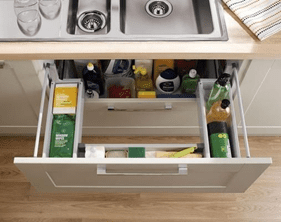The kitchen is one of the most important rooms in the entire home and often ends up being the one with very limited space. It is not easy to plan a good kitchen layout that not only lets you have space to walk but stores all the kitchen appliances and dishes. It gets frustrating to find even a single fork if your kitchen is not properly organised. That’s where kitchen drawer storage can be a lifesaver. They are different from kitchen shelves or cabinets. If planned strategically, the entire space below your stover countertop can make ample drawer space to store almost all kitchen appliances and cutlery. And they make the kitchen look clean as the dishes are hidden away.
Planning good kitchen drawer space can be tricky since all dishes and appliances are of different sizes and weights; it is important to compartmentalise them correctly. This will make it easier for you to find a particular category of items in one place and also preserve them from breaking. And if you are thinking of building a modular kitchen, or are renovating it, here are some cool and new kitchen drawer design ideas you must incorporate into your space planning.
Trending and functional kitchen drawer designs to choose from
Here is a list of the best kitchen drawer design ideas you can pick for your home.
Kitchen drawer design for cutlery storage

We all have organised parties or get-togethers at home and realised just how irritating it gets to find extra spoons or that specific spatula to stir pots. They always seem to hide away and are impossible to find if not properly stored. The first drawers should always be dedicated to flat and small utensils. Since, due to their shape, they take up less space and weigh less than big pans, it is better to have the top drawers dedicated to them. We also require them the most.
Build a systematically sectioned cutlery drawer with assigned spaces for forks, spoons, knives and spatulas/whisks. Having sections in the drawers also makes it visibly easy to find the exact cutlery you are looking for. The sections can be made of stainless steel for durability, or buy market-sold temporary shelves that you can just insert in the build drawer and create compartments.
Deep kitchen drawer design for big pots and pans

Source: Pinterest
The most problematic storage requirements are for those bulky pots and pans that we seldom use but still need to have nearby during gatherings. Since they are heavier than small cutleries, they automatically need a wider space. Usually, the bottom part of the drawers is used to store them.
Build drawers with enough depth to properly hold bulky dishes and utensils. They also give you a clear top view of where a particular pot is, so you can easily fetch them out. Build strong steel bases with easy-rotating wheels that can easily slide the drawers out. The strong base will help the drawers not cave in or break. You can use the bottom part of the drawer space to build them or have the entire drawer space dedicated to them, divided into two parts, depending on the number of utensils you have.
Kitchen drawer design for glass bottles

Source: Pinterest
More fragile kitchen items like sauce and oil bottles or those unopened wine bottles must have their separate space to save them from breaking. Even though one does require using sauces or oil almost every day, it still creates clutter when kept on the countertop, so to keep your kitchen less messy, you can invest in building a vertically shaped drawer to hold the cylindrical bottles.
Build the bottle drawers in a vertical manner rather than horizontally. The upward space will make it easy for you to tuck away the long bottles. Use dividers to separate the different categories of bottles, so they do not bump into each other and spill. Another important tip is to use non-sticky drawer liners that will be easy to clean the liquids if some spill down.
Kitchen drawer design for cutting board and trays

Source: Pinterest
Build a separate pullout drawer with narrow dividers to store away cutting boards and trays when not in need. Keeping them stacked will result in you wasting your time away to find a particular one. They also tend to skid away and fall. But putting them in a confined space will make them stay put. Build the dividers with steel or use wooden panels, whatever goes with the furniture theme of your kitchen.
Angular L-shaped corner kitchen drawers

Source: Pinterest
Almost all kitchens have an L-shaped counter layout that helps the owner use two sides of the wall for storage and other purposes. Since drawers are built in a rectangular shape, the corners often get unused. To not let them go to waste, interior designers use the trick of building an angled L-shaped drawer that helps store additional stuff in the kitchen.
When built smartly, these less spacious but still practical storage drawers can help you tuck away less needed or delicate items in the corner. They can be made deep or narrow. Adding shelves on the inner side of the gates and having shelves inside the drawer that slides out whenever you open the cabinet can offer you so much space for storing small and heavy objects in sections. You can also experiment with the layout of the drawers, have sliders as mentioned above or have three to two separate drawers to store miscellaneous objects or cups and saucers or have deep drawers to store heavy objects.
Sink drawers for kitchen

Source: Pinterest
The messiest corner in any kitchen is the sink area. Washing dishes, throwing away leftovers or cleaning vegetables, this space easily gets cluttered due to soap, towels and other sink ware being placed around the area. Instead of creating a messy space, how about building an accommodate sink drawer just below it?
Build a U-shaped sink drawer just below the sink to store all the sink ware items. They will be easy to reach when doing the dishes instead of hunting for them, and tuck them away when done to keep the space clean as well. Add dividers to keep the products separate. If you are building a wooden drawer, use rust-free steel shelves with grids or holes so the water can evaporate. Seal away the edges of the drawers, so they do not get damaged by moisture.
Kitchen drawer design for plates

Source: Pinterest
If you’re looking for a storage solution that is both practical and convenient, consider a pull-out plate rack for your kitchen. This type of rack is a great alternative to storing plates in upper cupboards or having a cluttered mess of pot lids in drawers. With a pull-out plate rack, you can easily access and store plates of various sizes, as well as other items like bowls and cups. The racks often come with movable dividers, making it easy to adjust the space to accommodate your dishes. This type of rack is a flexible storage option that maximises space and keeps your kitchen organised.
Kitchen drawer design with spice jar organiser

Source: Pinterest
A spice drawer design with multiple tiers and lots of space is an excellent option for those who love cooking and experimenting with different flavours. These types of spice drawers usually have three or more tiers, allowing you to store a variety of spices in an organised and accessible manner. Some models even feature adjustable dividers, allowing you to customise the size of the compartments to suit your needs. Another advantage of this design is that it allows you to easily see and access your spices without having to rummage through a cluttered cabinet or shelf. The multiple tiers also help maximise the use of vertical space in your kitchen, making it a practical choice for those with limited counter or cabinet space.
Kitchen drawer design with magnetic knife strip

Source: The Cavender Diary (Pinterest)
Enhance both safety and aesthetics in your kitchen by integrating a magnetic knife strip into your drawer design. This innovative solution not only keeps your knives securely in place but also adds a touch of modern elegance to your kitchen space. By storing your knives horizontally within the drawer, you free up valuable countertop space and eliminate the need for bulky knife blocks, creating a cleaner and more organised cooking environment.
Kitchen drawer design with adjustable drawer dividers

Source: The 36th Avenue (Pinterest)
Achieve optimal organisation in your kitchen with the flexibility of adjustable drawer dividers. These versatile additions allow you to tailor the interior of your drawers to suit your specific storage needs. From cutlery and utensils to cookware and accessories, each item finds its rightful place, making it easier than ever to locate what you require while maintaining a clutter-free appearance.
Kitchen drawer design with hidden charging station

Source: House Beautiful (Pinterest)
Embrace the digital age and simplify your kitchen’s functionality with a discreetly concealed charging station. Designed to keep your electronic devices powered up and conveniently stowed away, this feature ensures that your kitchen remains uncluttered and free from tangled cords. From smartphones to tablets, you can recharge your gadgets while preparing meals or enjoying quality time with family and friends.
Kitchen drawer with pull-out cutting board

Source: Segreto Finishes (Pinterest)
Revolutionise your meal preparation process by incorporating a pull-out cutting board into your kitchen drawer design. This space-saving solution offers a dedicated surface for slicing, chopping, and dicing, all neatly tucked away when not in use. Say goodbye to overcrowded countertops and hello to a more efficient cooking experience. With a pull-out cutting board, you’ll have an easily accessible workstation that can be effortlessly stowed away once your culinary masterpiece is complete.
FAQs
What are the appropriate places to build a kitchen drawer?
Build utensil drawers below the stove; cutlery and glass drawers need to be beside the dishes drawer. Have drawers containing spices near the cooking area.
What materials should I use to build my kitchen drawers?
Plywood is the preferred choice when building the bottom side of the drawers as it can handle the weight and does not shrink. Use premium solid wood for the front and side parts. Use metal or steel grids for shelves and compartments inside the drawer.
| Got any questions or point of view on our article? We would love to hear from you. Write to our Editor-in-Chief Jhumur Ghosh at jhumur.ghosh1@housing.com |







